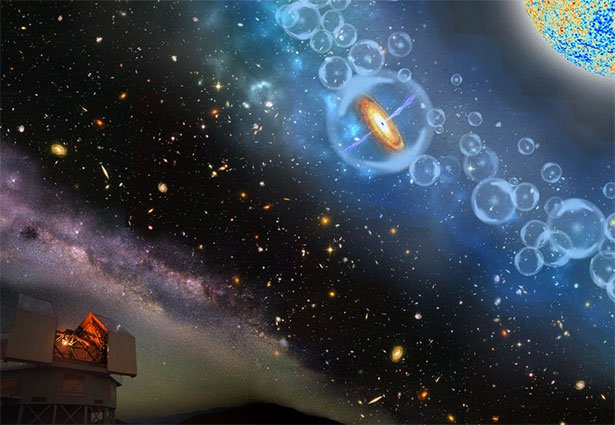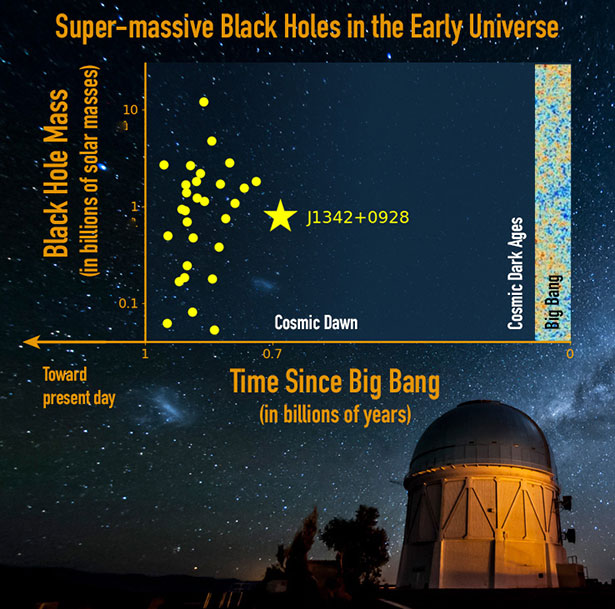Astronomers discover oldest Quasar
Supermassive black hole from the time of only 690 million years after the big bang
Cosmic record: Astronomers have discovered the oldest quasar of the cosmos to date. The supermassive black hole is more than 13 billion years old. The strange thing about it: although the quasar dates back to only 690 million years after the Big Bang, it is a real mass giant, as the researchers report in the professional magazine "Nature". Also exciting: The light of the quasar gives insight into a time of upheaval in the universe, the reionization.

Astronomers have discovered an active supermassive black hole that dates back to only 690 million years after the Big Bang. © Robin Dienel/ Carnegie Institution for ScienceQuasars are among the brightest objects in the cosmos: the light of these active galaxies is visible over billions of light years and therefore offers unique insights into the early days of the universe. It occurs when the supermassive hole in the center of such a galaxy sucks in and swallows large amounts of matter.
But despite their enormous radiance, very distant old quasars are rare and difficult to detect. To date, astronomers have only discovered about 100 quasars that are older than twelve billion years. And only one of them reaches almost 13 billion years. For its light, astronomers determined a redshift of z=7.1 - this corresponds to an age of 12.9 billion years.
Sophisticated tracing
Astronomers around Eduardo Bañados from the Carnegie Institution for Science in Pasadena have discovered a quasar that is even further away than all the previous findings. They tracked it down through the comparative data analysis of three different celestial surveys.
The astronomers searched specifically for objects that appear in infrared telescopes because of their large redshift, but not in the images of optical telescopes. A cosmic object was found during this search: the Quasar J1342 + 0928. To learn more about the age and properties of this object, they observed the quasar with several powerful telescopes and analyzed its light spectrum.
Only 690 years after the big bang

The quasar originates from the time of Reionization - one of the great phase transitions of our universe. © Robin Dienel/ Carnegie Institution for Science
The result: J1342+0928 is the oldest and most distant quasar ever. It has a redshift of 7.54, as the spectral analyses showed.
His light comes from a period of only 690 million years after the Big Bang, Bañados and his colleagues report.
The universe only had five percent of its present age at that time. The newly discovered quasar is by far the oldest quasar ever discovered.
Also exciting: The new record holder comes from a period of upheaval in the cosmos - the era of reionization. In this phase, the intense light of the young stars robbed electrons from the hydrogen gas, which had until then been neutral, and thus ionized it.
Reionization was the last great phase transition of the universe, Bañados explains.
But when and how exactly the reionization took place has so far only been partially clarified.
Ongoing reionization
The quasar J1342+0928 now provides another indication. The spectral analyses of its light suggest that part of the hydrogen in its environment must still have been neutral - between 38 and 77 percent, depending on the calculation method. In the opinion of astronomers, this could indicate that reionization was not yet complete at that time.
The fact that both quasars known to date show indications of neutral hydrogen with a redshift z>7 confirms that our observations have penetrated into the era of reionization, the researchers state.
Thus, the new quasar observation supports those cosmological models in which reionization only comes to an end relatively late in cosmic history.
Too massive for its time

J1342+0928 is unusually bright and massive for its age © Robin Dienel/ Carnegie Institution for Science
And something else is extraordinary: J1342+0928 is very bright and extremely massive. According to astronomers' calculations, the quasar releases around 40 trillion times as much energy per second as the sun. The researchers also found out from brightness and light spectrum that the supermassive black hole had to comprise about 800 million solar masses. By way of comparison, the black hole in the center of the Milky Way has only around three million solar masses.
Explaining how these objects have accumulated this mass in less than 690 million years is a real challenge for our theories on the growth of such supermassive black holes, says Bañados.
Robert Simcoe of the Kavli institute adds:
At that time, the universe wasn't old enough to produce such a large black hole - that's very mysterious.
For this means either that the early black holes grew faster than previously assumed, or that the forerunner of this cosmic giant must have already reached a considerable size less than 100 million years after the Big Bang.
Unique insights
The first observations of this quasar have already provided valuable insights into the early history of the cosmos - and raised new questions.
This is a very exciting discovery, says Daniel Stern from NASA's Jet Propulsion Laboratory.
He and his colleagues hope that follow-up observations will reveal further details about this quasar and its era.
The astronomers also want to continue to search for comparable distant quasars.
Hopefully, with the even more sensitive next-generation facilities being built, we can make many exciting discoveries in the early universe, says Stern.
Source: Nature, 2017; doi: 10.1038 / nature25180

thanks for education on science.
great information on science thank.
nice post on science love to read thanks for share.
Congratulations! This post has been upvoted from the communal account, @minnowsupport, by n3bul4 from the Minnow Support Project. It's a witness project run by aggroed, ausbitbank, teamsteem, theprophet0, someguy123, neoxian, followbtcnews/crimsonclad, and netuoso. The goal is to help Steemit grow by supporting Minnows and creating a social network. Please find us in the Peace, Abundance, and Liberty Network (PALnet) Discord Channel. It's a completely public and open space to all members of the Steemit community who voluntarily choose to be there.
If you would like to delegate to the Minnow Support Project you can do so by clicking on the following links: 50SP, 100SP, 250SP, 500SP, 1000SP, 5000SP. Be sure to leave at least 50SP undelegated on your account.